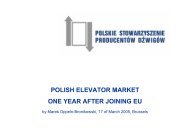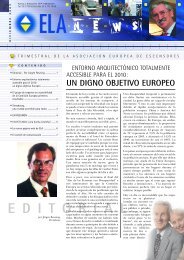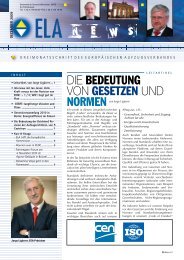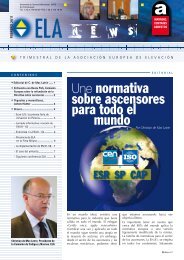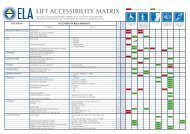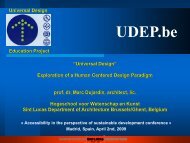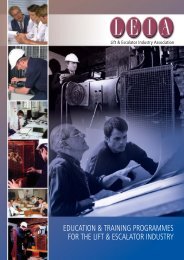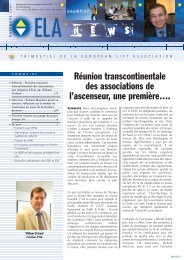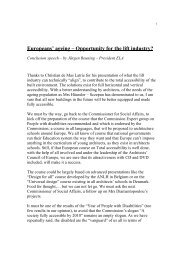WP6-Brochure-E4 brochure - ELA European Lift Association.
WP6-Brochure-E4 brochure - ELA European Lift Association.
WP6-Brochure-E4 brochure - ELA European Lift Association.
Create successful ePaper yourself
Turn your PDF publications into a flip-book with our unique Google optimized e-Paper software.
not rate an item. Reasons for non‐rating were various, e.g. respondents stating they did not<br />
have any knowledge on a certain topic or not providing clear answers. The barriers that were<br />
rated to be most relevant are coloured red, those least important, green. These highlights<br />
provide a homogeneous picture: barriers to energy efficiency – from the point of view of the<br />
experts surveyed – are mainly due to lack of information and transparency regarding energy<br />
consumption of equipment (cf. operators not monitoring energy costs, decision‐makers not<br />
aware of energy consumption) and split incentive issues in relation to bounded rationality (cf.<br />
energy costs not paid by decision‐maker, investment more important than life‐cycle costs,<br />
components would be more efficient if operators had more transparency). Risks and<br />
uncertainties play a minor role, as shown by the green highlights, while capital issues received<br />
middle‐range ratings. However, the items on lack of capital in new installations and retrofit<br />
were also those which are based on the lowest number of ratings, i.e. nine and ten<br />
respondents respectively did not provide a rating.<br />
Information and transaction costs<br />
In general, ratings indicate that, in the experience of the experts interviewed, it is not common<br />
that operators of lifts or escalators regularly monitor the energy consumption of their<br />
equipment. In most cases, no technical appliances are installed that would enable regular<br />
monitoring; thus the energy consumption of lifts and escalators cannot be separated from<br />
other equipment, e.g. lighting, automatic doors.<br />
This is seen as related to the fact that individuals choosing equipment as well as operators and<br />
users are not aware of the energy consumption of the equipment. Due to a low degree of<br />
awareness, no measurement devices are installed – and due to missing data, individuals do not<br />
become aware of potentials to increase the energy efficiency of their installations.<br />
Information on energy‐efficient technology is, however, not regarded as especially difficult to<br />
obtain. Main sources of information that were identified by the respondents are, however, the<br />
manufacturers and their sales representatives. Thus neutral sources of information are missing<br />
or insufficiently known. 5 The experts emphasised that the knowledge provided by sales<br />
representatives is usually restricted to the technology used by their company and that energyefficient<br />
technology is sometimes too new to be fully understood, even by company<br />
representatives. Additionally, clients are seen as usually having little knowledge themselves,<br />
and thus do not inquire about relevant data.<br />
Split incentives and bounded rationality<br />
Split incentives between general contractors, owners of installations as well as those paying<br />
for the energy consumption of installations are also seen as a barrier hindering energy<br />
efficiency for lifts and escalators. The costs of energy consumption are usually paid by<br />
inhabitants – in the residential sector – who are not necessarily the owner of the building.<br />
Additionally, buildings including a lift or escalator are often erected by a general contractor for<br />
5 For example, in Germany, neutral information may be obtained from notified bodies.<br />
97



